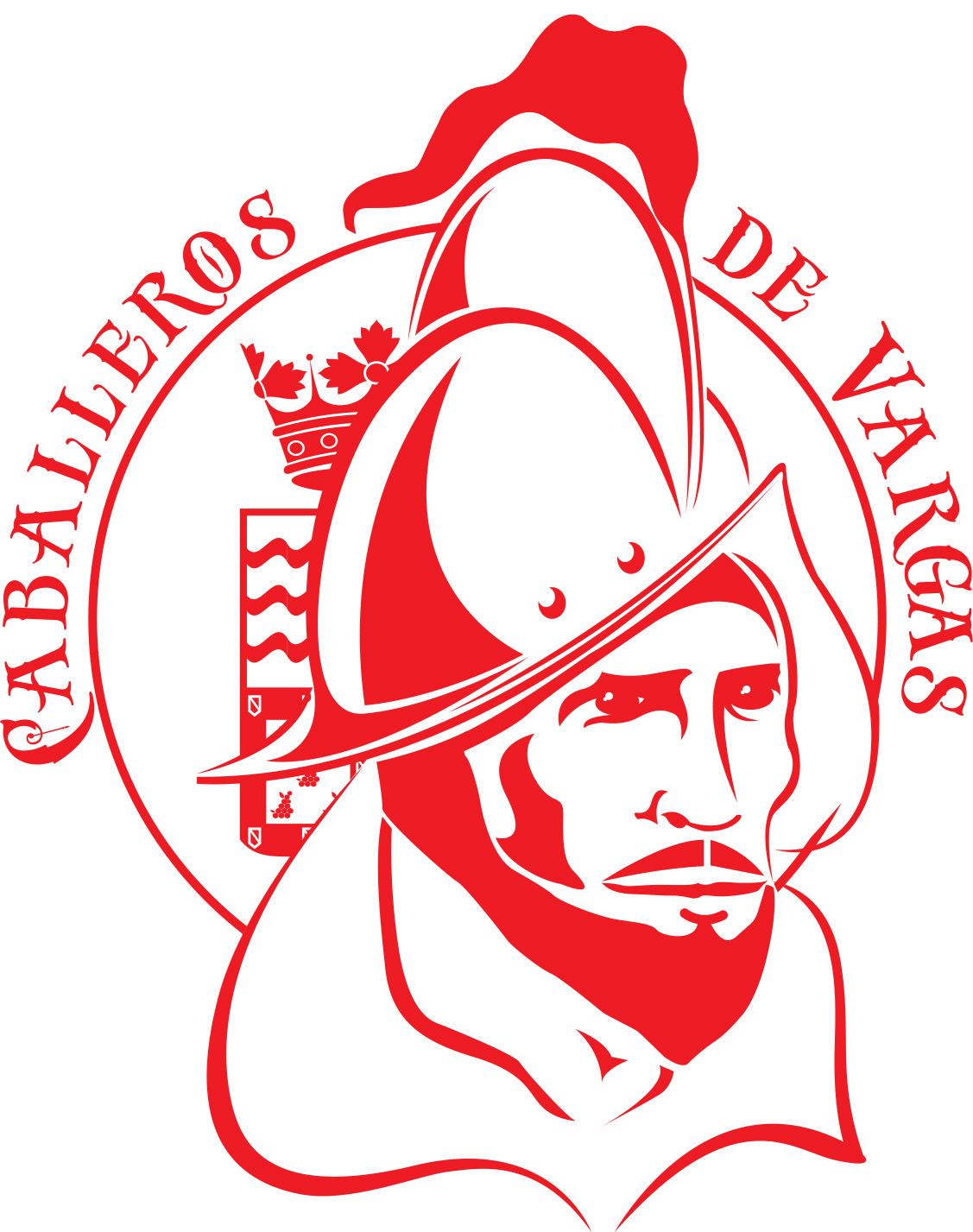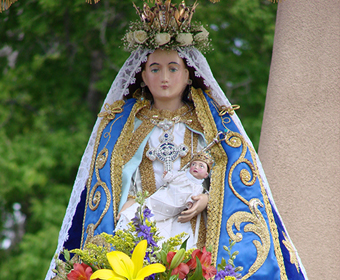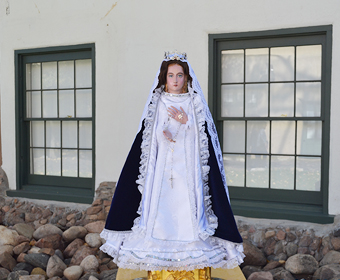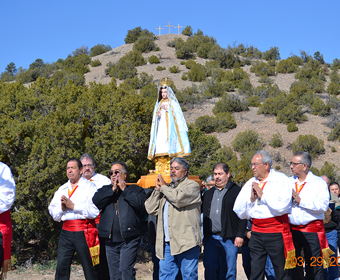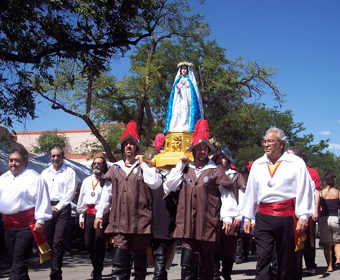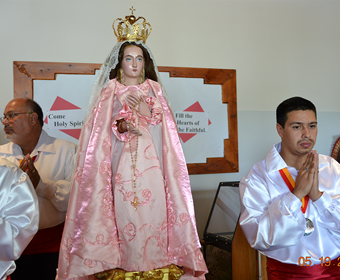La Conquistadora:
A bit of history:
La Conquistadora was the most valuable piece of religious art in all of New Mexico. Created in Spain and transported to colonial Mexico by ship, the statue had been brought to New Mexico on the Camino Real (Royal Road) by December 1625.
Forty-five years after her arrival on this far northern frontier, La Conquistadora had been hurriedly rescued from the main church in Santa Fe when the pueblo Indians rose up in rebellion. Killing at least 400 Spaniards, the rebels had destroyed all Catholic churches and most pieces of religious art found within them. La Conquistadora was fortunate to have been carried away in the arms of a devout woman named Josefa López Sambrano de Grijalva.
About 2,000 Spanish survivors fled to El Paso, far to the south. As much a survivor as her fellow human exiles, La Conquistadora “resided” in an El Paso mission church from 1680 to 1693.
When Don Diego de Vargas led the reconquest of New Mexico in 1693, he brought La Conquistadora as precious cargo on the first caravan of returning soldiers and settlers. Eighteen Franciscan missionaries sang hymns to the image of Mary as they transported her back to Santa Fe in a specially built two-wheeled vehicle.
To celebrate the Spanish reconquest of New Mexico in 1693, La Conquistadora is traditionally carried at the head of the procession that leads from Rosario Chapel to St. Francis Cathedral in preparation for the Santa Fe Fiesta held in late August and early September each year.
At least one older woman recalled a strange happening before this procession began the year before La Conquistadora’s kidnapping in 1973. The woman remembered that when several men attempted to lift La Conquistadora at Rosario Chapel, the statue grew unbearably heavy, as if it wanted to remain at the chapel rather than return to the cathedral and imminent danger. Stories of suddenly heavy religious statues abound, but this one seemed particularly ominous in retrospect.
Where was La Conquistadora? Part 1
State and local police used all available manpower as they launched their search and investigation. La Conquistadora’s altar was meticulously checked for fingerprints, but none were found. Only a single set of footprints was discovered to help the police identity La Conquistadora’s abductor. There was no sign of breaking and entering at any of the cathedral’s doors. Santa Fe detectives, led by Paul Baca and Mike Montoya, surmised that one or two perpetrators had probably hidden in the choir loft or elsewhere in the huge cathedral as the building was being locked for the night on March 18.
When all was quiet, the intruders had apparently climbed to the high niche where La Conquistadora normally stood, grabbed the holy statue and fled from the church in the dark of night. If true, theirs had been a direct and simple plan, as most successful criminal plans are in history. With few physical clues to work with, detectives interviewed at least eight persons who might have had information about the theft. Several people agreed to take lie detector tests. Unfortunately, these interviews left the police with as many questions as answers in the puzzling mystery.
For example, the police pondered why La Conquistadora had been kidnapped in the first place. Given her fame, she could not possibly be sold either in the legitimate art world or on the nefarious black market.
Some wondered if the kidnappers had taken La Conquistadora in hopes of portraying themselves as citizens who had somehow discovered the lost statue and had turned it over to the police to reap the reward that was bound to be offered. In fact, local businesses and groups had pledged about $1,500 in reward money within days of the crime.
Or would the kidnappers soon contact church leaders to make demands for a ransom of much higher value? Would they threaten to damage or even destroy the sacred image if their demands were not met?
Police also wondered if this crime was related to recent thefts of other religious art in the capital. On July 5, 1972, a valuable statue of San Miguel, as well as other statues and paintings, had been stolen from San Miguel Mission, the oldest church in the United States. (According to one theory, La Conquistadora had gone off in search of the lost San Miguel because he’d been gone so long and clearly needed help in finding his way back home!) Or could the crimes at St. Francis and San Miguel be related to a series of thefts from 24 churches and Penitente moradas (chapels) in northern New Mexico over the previous two years? Close to a hundred religious artifacts, valued at over $100,000, were recovered from galleries, private collections, and art dealers by November 1972, but no arrests had been made and the perpetrators were still on the loose in the spring of the following year.
Finally, there was the possibility that La Conquistadora’s kidnappers may have learned of these previous crimes and were boldly attempting a copycat caper with far higher stakes and much greater risks. Rumors of La Conquistadora’s possible whereabouts circulated widely, as rumors often do in the capital city. Some speculated that La Conquistadora was being kept in northern New Mexico, not far from Santa Fe. Others believed that she had been taken south to Albuquerque.
Another group thought that La Conquistadora had been transported as far away as the East Coast where she was less well known and could fetch a handsome price on the national or international black market. Legitimate art dealers, museums, and collectors across the nation were notified to be on the alert. But nothing happened for several days, despite the relentless efforts of police officers and the countless prayers of Catholics across the state.
Reflecting the anguish of many New Mexicans, a poet named Magdalena Vigil wrote:
Qué triste estamos sin ti! How sad we are without you!
Qué vamos a hacer ahora? What are we to do now?
Vuelve pronto con nosotros, Return quickly to us,
O Virgen Conquistadora! O Virgin Conquistadora!
Catholics in the Rio Abajo had an especially strong devotion to La Conquistadora. Although the statue of Mary had been permanently displayed at St. Francis Cathedral, La Conquistadora had occasionally traveled to various parts of New Mexico on special religious occasions. In May 1954, for example, La Conquistadora had toured several central and southern New Mexico communities to the enthusiastic reception of thousands of devoted church members. Accompanied by Fray Angélico Chávez, the statue visited churches in Isleta, Tomé, La Joya and Socorro. On Thursday, May 20, it visited Belen for the first time in the town’s history. La Conquistadora arrived in Belen on schedule that Thursday afternoon. A large procession was planned, with the statue carried from the home of Placido Jaramillo, at 700 North Main St., (where the Circle K now stands at Aragon and Main), to Our Lady of Belen Church off South Main.
Senior Girl Scouts of the parish carried La Conquistadora on a portable throne. Fourth-degree members of the Knights of Columbus served as her honor guard. Once at the church, an estimated 3,000 parishioners attended a solemn High Mass celebrated by Our Lady of Belen’s Reverend Aloysius Boland. Fray Angélico delivered a stirring sermon.
Many years had passed since that eventful day in 1954, but many residents of Valencia County remembered the procession and Mass quite vividly. Learning of La Conquistadora’s disappearance, these local men and women prayed fervently for the statue’s safe return. Little did the people of Valencia County know that their region of the state was about to play a key role in resolving the mystery of La Conquistadora’s disappearance in 1973.
No one in the county or the state could have anticipated the dramatic events that were about to unfold.
Part 2: La Conquistadora discovered unharmed in Valencia County mine
Three weeks after La Conquistadora’s kidnapping, the police and Catholic church officials had yet to receive word from her abductors, either by mail or by phone. The entire state held its collective breath.
Thousands prayed for La Conquistadora’s safe return. Many feared that the chances of recovering La Conquistadora grew dimmer as her kidnappers’ trail grew colder.
The case of La Conquistadora’s disappearance finally broke on Saturday, April 7, 1973. On that date, Father Miguel Baca at St. Francis Cathedral received a letter from someone who claimed to know of La Conquistadora’s whereabouts. To prove that the ransom note was not bogus, the letter’s envelope also contained a cross from La Conquistadora’s crown.
Written in poor Italian, the ransom note stated that La Conquistadora would be returned unharmed in exchange for a ransom of $150,000 and a promise from Gov. Bruce King that those involved in the crime would not face criminal prosecution.
If church leaders agreed to these terms, Father Baca was instructed to ring the cathedral’s bells exactly 10 times at 4:45 p.m. on Wednesday, April 11. If the bells were rung at the designated time, the kidnappers would deliver additional instructions by phone the following day.
Encouraged, lead detectives Paul Baca and Mike Montoya told Father Baca to ring the cathedral’s bells as instructed in the ransom note. The bells rang 10 times at precisely the right moment on April 11.
Meanwhile, the police installed electronic equipment to intercept calls received in offices at St. Francis Cathedral. Detectives hoped they’d be able to trace incoming calls when the kidnappers attempted to communicate, as promised in their note.
But the phone call never came on Thursday, April 12. Instead, church leaders and city police had to wait until 8:20 on Friday evening. Although this first phone contact did not last long enough to trace the caller, a second call, made moments later, produced the desired results, thanks to Father Baca’s success in stalling the kidnapper. The call was traced to a residential address in Santa Fe.
Events unfolded quickly. Armed with a search warrant, detectives Montoya and Baca rushed to the Santa Fe address and arrested their suspect, a slim 17-year-old Hispanic youth the police had had under surveillance for some time, thanks to the help of an informant whose identity was withheld for his (or her) protection.
After two hours of questioning in his parents’ presence, the teenager confessed and, in the process, implicated an 18-year-old friend who had attended high school in Santa Fe, but who now lived in northeast Albuquerque. The police arrested 18-year-old Arthur W. McComb within hours.
The older boy was charged with larceny, desecration of a church, criminal damage of property and contributing to the delinquency of a minor. With a previous juvenile record, McComb was held on $40,000 bond.
The Santa Fe minor was so cooperative that he agreed to lead the police to where La Conquistadora could be found. Eager to retrieve the statue as soon as possible, Montoya, Baca, Santa Fe police chief Felix Lujan and police captain Alfred Lucero accompanied the 17-year-old to La Conquistadora’s location in the cold early morning hours of Saturday, April 14.
Despite previous rumors that La Conquistadora had been hidden somewhere north of Santa Fe or south in Albuquerque, her actual location was in Valencia County.
The minor, whose name was withheld because of his age, led police to the foothills of the Manzano Mountains, east of Los Lunas. The small group hiked about three miles, and, after crossing a stream, approached a remote, abandoned mine.
Using only two flashlights, the men followed the youth about 200 yards into the mine. There the police finally found La Conquistadora, safely wrapped in foam padding and secured in a large plastic bag. Other stolen works of art were also discovered, including valuable missing artifacts from the San Miguel mission church.
The detectives carefully carried La Conquistadora and the San Miguel art to their car and began the long journey home.
La Conquistadora and her entourage arrived at Santa Fe police headquarters at 7 a.m. Bells from the nearby cathedral rang just as the police removed La Conquistadora from their vehicle.
Newspapers across the Southwest announced La Conquistadora’s recovery with banner headlines. Santa Fe’s downtown merchants displayed pictures of the rescued statue in their storefront windows.
Catholics uttered prayers of thanksgiving and planned both a grand procession and a solemn Mass to welcome La Conquistadora home.
New Mexicans had much to celebrate. But there were many unsolved loose ends in this mystery. Where, for example, was La Conquistadora’s crown?
The statue’s original crown had not been stolen in March because it was normally stored in a heavily insured First National Bank of Santa Fe vault. But La Conquistadora had been wearing an imitation gold crown when she’d been kidnapped and this second, still-valuable headpiece was missing when the statue was brought to police headquarters in Santa Fe.
Detective Baca worried that in his haste to move La Conquistadora from the mine to his police car on April 14 the crown may have accidentally fallen off, unnoticed in the dim pre-dawn light.
And so detectives Baca and Montoya returned to Valencia County by helicopter to retrace their steps to and from the abandoned mine in the Manzano Mountains. They searched for three hours on Monday, April 16, but found no sign of the crown. Instead, they discovered a large quantity of explosives in the mine, making La Conquistadora’s survival in the mine even more miraculous.
To everyone’s relief, La Conquistadora’s crown was soon discovered in an arroyo six miles south of Santa Fe where it had apparently been left by the teenage thieves.
La Conquistadora’s homecoming to St. Francis Cathedral took place on Sunday, April 29, 1973. Reporters on the scene noted that few people lined the streets of Santa Fe because most people–an estimated 2,500–took part in the procession itself. Three city blocks in length, the procession was the largest held in Santa Fe in many years.
Appropriately, detectives Montoya and Baca were among those chosen to carry (and guard) La Conquistadora on her throne. According to the press, cathedral bells rang loudly and joyously throughout the momentous event.
Once in St. Francis Cathedral, the capacity crowd watched as La Conquistadora was triumphantly placed back in her chapel to the north of the cathedral’s main sanctuary. At 3 p.m. Archbishop James Peter Davis celebrated a solemn Mass of thanksgiving. Father Baca delivered the sermon. La Conquistadora was home at last.
To the relief of many, La Conquistadora was able to play her traditional role in the annual procession during the 1973 Santa Fe Fiesta, less than four months later. As usual, her impressive entourage included Santa Fe policemen on motorcycles, a color guard bearing papal and American flags, the fiesta queen and her court, Catholic clergy, a choir, flower girls, the Confraternity of La Conquistadora and the Caballeros de Vargas, who bore the esteemed statue.
And what became of the teenage thieves? After a two-month evaluation, a psychologist concluded that Arthur McComb had had an overriding “desire to become a master criminal.” Only the prospect of a long prison term at the state penitentiary changed McComb’s attitude and lifetime goal.
In June 1973 he and his accomplice agreed to plea bargains. Showing overt remorse for his actions, McComb announced to the court that he was “finished with crime” and had devoted his life to God.
Tried as an adult, McComb received the maximum sentence of one to five years in prison. Still a juvenile, McComb’s younger friend was sentenced to the New Mexico State Boys School in Springer until he reached his 18th birthday.
Some observers thought that these punishments were too mild. Others believed it would be best for the boys to serve longer prison terms for their own protection from the bitter public at large.
But most New Mexicans were simply glad that La Conquistadora’s ordeal was over and that she had somehow remained safe in a desolate mountain mineshaft. We can only speculate about how she escaped greater harm.
Perhaps a legend of the Rio Abajo can help explain what transpired. According to this legend, a Spanish colonial soldier named Juan Soldado had discovered a valuable mine in the Manzano Mountains sometime in the 18th century. To this day, Juan’s ghost reportedly guards his find from intruders who might try to steal the mine’s riches for themselves.
Even when travelers have discovered his treasure and have left items (from bandanas to rifles) to identify the mine’s location, their markers have consistently disappeared when the men eventually returned to the area. Thanks to Juan, the remote location remained a secret for centuries.
We can only speculate that Arthur McComb and his friend had found Juan’s secluded mineshaft and had hidden La Conquistadora in it shortly after her abduction on March 18. It was a devout Juan who had kept watch over the statue and had assured its safety for the three weeks it remained in his mine. A good soldier, Juan had guarded the mine’s entrance, keeping out trespassers and only permitting the police to enter so they could rescue the priceless icon at last.
Pedro Ribera-Ortega, a highly respected leader of La Confradía de Nuestra Señora del Rosario, had a much different explanation of how La Conquistadora had survived. According to Ribera-Ortega, La Conquistadora had “allowed herself to be stolen to show us that we weren’t taking care of our saints” and that security for the sacred statue needed to be vastly improved.
If this was her intent, La Conquistadora succeeded. Security at St. Francis Cathedral has improved considerably, and church officials have gone so far as to have a replica of La Conquistadora made so the replica, known as La Conquistadora Peregrina (or the Traveling Conquistadora), can travel around the state while the original statue remains safely at home.
La Conquistadora (or at least La Peregrina) returned to Valencia County when she visited Our Lady of Belen Church on April 30, 1998, as part of that year’s Cuarto Centenario celebration. Arriving at noon in a chauffeured, air-conditioned RV, La Conquistadora was received by a crowd of devoted local parishioners.
Twenty-five years and a day had passed since the statue’s triumphant return to St. Francis Cathedral in 1973. The residents of Belen were glad to help La Conquistadora, the church and all New Mexicans celebrate the anniversary of a perplexing mystery of the Rio Arriba that was ultimately resolved to everyone’s satisfaction in the Rio Abajo.
Subscribe to Our Newsletter
Are you looking to stay in touch? Sign up and we will send you periodic emails with information about the organization.
Address
PO BOX 1403
Santa Fe, NM 87504
Call Us
(505) 699.1877
Email Us
delgadog56@gmail.com
